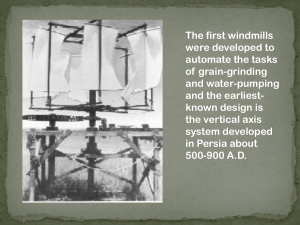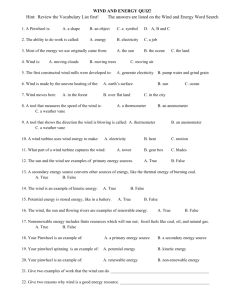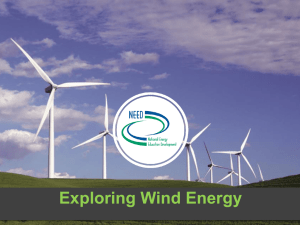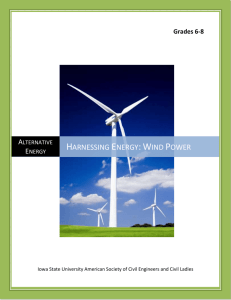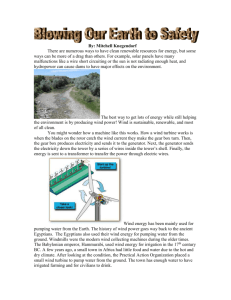Lesson Two Windmills
advertisement
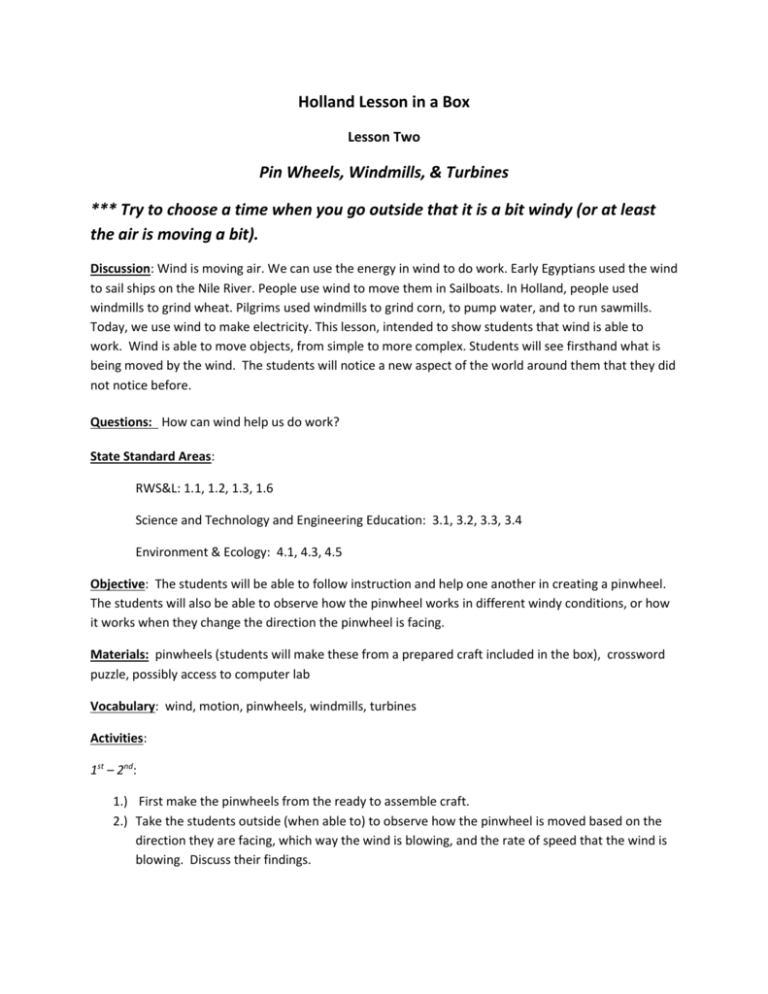
Holland Lesson in a Box Lesson Two Pin Wheels, Windmills, & Turbines *** Try to choose a time when you go outside that it is a bit windy (or at least the air is moving a bit). Discussion: Wind is moving air. We can use the energy in wind to do work. Early Egyptians used the wind to sail ships on the Nile River. People use wind to move them in Sailboats. In Holland, people used windmills to grind wheat. Pilgrims used windmills to grind corn, to pump water, and to run sawmills. Today, we use wind to make electricity. This lesson, intended to show students that wind is able to work. Wind is able to move objects, from simple to more complex. Students will see firsthand what is being moved by the wind. The students will notice a new aspect of the world around them that they did not notice before. Questions: How can wind help us do work? State Standard Areas: RWS&L: 1.1, 1.2, 1.3, 1.6 Science and Technology and Engineering Education: 3.1, 3.2, 3.3, 3.4 Environment & Ecology: 4.1, 4.3, 4.5 Objective: The students will be able to follow instruction and help one another in creating a pinwheel. The students will also be able to observe how the pinwheel works in different windy conditions, or how it works when they change the direction the pinwheel is facing. Materials: pinwheels (students will make these from a prepared craft included in the box), crossword puzzle, possibly access to computer lab Vocabulary: wind, motion, pinwheels, windmills, turbines Activities: 1st – 2nd: 1.) First make the pinwheels from the ready to assemble craft. 2.) Take the students outside (when able to) to observe how the pinwheel is moved based on the direction they are facing, which way the wind is blowing, and the rate of speed that the wind is blowing. Discuss their findings. 3rd – 8th: 1.) Complete steps above. 2.) Discuss or relate the following information - Wind is free, but to harness it we need a wind turbine, sometimes called a wind generator. By using wind turbines, we are able to harness the power of the wind and convert it into electricity. Our search for renewable sources of energy has led us to consider and develop wind power as a source of energy. There are two types of wind turbine that are regularly used to create energy on a large scale, and both work on the same basic principles. As the wind travels into and through the blades, they rotate and turn a shaft. In turn, this shaft connects to a generator (like a dynamo used to power a bicycle light) that will create the electricity. A two-blade turbine faces away from the wind and a three-blade turbine faces into the wind. Typically, a large number of turbines are combined to create wind farms, capable of powering large numbers of buildings, but there are smaller single turbines available that you can place in your garden and use to power certain aspects of your house. 3.) Have students go to http://www.alliantenergykids.com/index.htm where they can learn more basics of wind energy and play online learning games about wind. 4.) Have students who are in older grades or more advanced go to http://www.talentfactory.dk/en/kids/index.htm The username and password I have set up are as follows: jebbert@hotmail.com migranted (*** As of June 3, 2012 I was still waiting for the webmaster at DWIA to activate my username and password for your use. Since this needed to go to publication you will need to see if they ever do activate it for your use or not.) This website is maintained by the Danish Wind Industry Association. The students should follow the animated character “Miller” through his travels, and answer his questions along the way. When students have completed their journey with “Miller” they should be able to complete the crossword puzzle that is enclosed. For your convenience the crossword key is also enclosed. Evaluation: The teacher will check for understanding by asking comprehension questions as well as noting participation in the activities and discussions. Extension Activities: Have students discuss what causes wind: Air is set in motion by the Pressure Gradient Force (PGF). This is a flow from high to low pressure. The second law of thermodynamics states that higher energy states move toward lower energy states. Nature is always trying to balance. The result of trying to balance and equalize pressure results in wind. What causes the pressure changes in the atmosphere? The primary reason is the warming of air by the sun. The pressure exerted by a gas changes as it becomes more or less dense. Because a cold air mass is denser and has a lower volume than warm air, pressure decreases more rapidly with height in cold air than in warm air. When cold dense air is placed next to warm less dense air, wind is formed as nature tries to balance the pressure differences at each level in the atmosphere between the two air masses. This can occur on all scales of motion. On a large scale, temperature gradients create the polar jet stream and sea breeze circulation; on the small scale, they create lake breezes. The pressure gradient force acts on a horizontal plane. Add the earth’s rotation, and you get global wind patterns as hot air rises at the equator and then sinks again in huge convection currents. Conditions on the ground, such as surface topography and the type of terrain, can alter wind speeds and direction considerably from the global circulation pictured below. Resources/Works Cited: The vast majority of this lesson comes from resources found at: http://www.energyforeducators.org/lessonplanstopic/wind.shtml http://www.talentfactory.dk/en/kids/index.htm www.armoredpenguin.com http://www.alliantenergykids.com/index.htm
